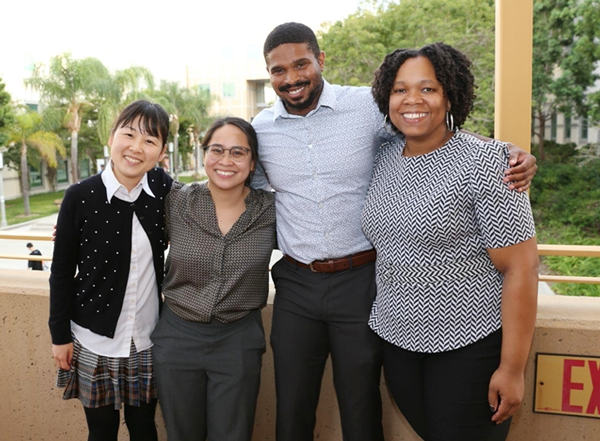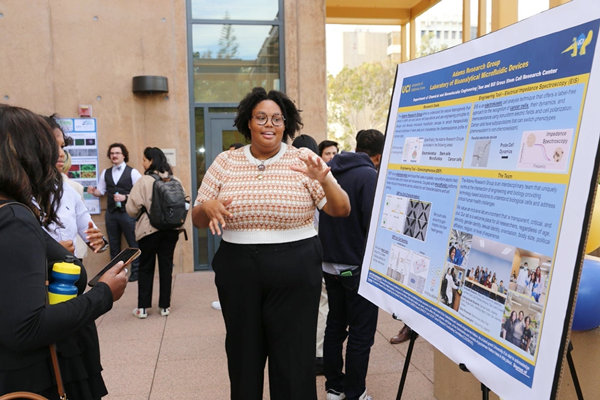New Faculty Cohort Uses Stem Cells in Tissue Engineering to Advance Regenerative Medicine

Jan. 26, 2023 – Around 60 people attended a networking showcase event celebrating the work of four assistant professors – Tayloria Adams, Herdeline “Digs” Ardoña, Quinton Smith and Momoko Watanabe – and their students who are conducting collaborative research in the field of regenerative medicine. The four professors, three from the Department of Chemical and Biomolecular Engineering (CBE) and one from the Department of Anatomy and Neurobiology, were hired over the past few years as part of UCI’s Faculty Hiring for Leveraged Research Excellence (FHLRE) program.
The goal of FHLRE is to build synergy across UCI institutes in an effort to innovate through interdisciplinary collaboration. A partnership between the Bill and Sue Gross Stem Cell Research Center (SCRC) and CBE brought together the school of medicine and school of engineering to hire these four faculty to accelerate stem cell-based tissue engineering research. The researchers came from across the country and are experts in modeling human development using stem cell-derived organoids and fabricating novel biomaterials to mimic tissue environments.
“These four faculty represent the very best of UCI: innovative science, interdisciplinary research and terrific collegiality, all with a deep commitment to advance diversity, access and inclusion,” said Vasan Venugopalan, professor and chair of CBE, who welcomed attendees and gave opening remarks. “I want to thank the school of engineering for their willingness to situate their labs in adjoining spaces, promoting interaction and collaboration, maximizing resources and supporting ongoing interactions with the Stem Cell Research Center, which is necessary for carrying forward this challenging work.”
The event, held Oct. 28, 2022, in the Colloquia Room and Engineering Hall, included food, presentations, posters, lab tours and demonstrations. Members from each lab presented their current research and answered attendees’ questions.
“Our goals in the stem cells in tissue engineering initiative are dynamic and consistently expanding due to advances in biotechnology,” said Smith. “For example, with the generation of patient-specific stem cells, novel biomaterials and additive manufacturing tools, we now have the capacity to organize human cells in 3D environments with bioprinting, which enables new insight into how tissues develop, organize and transition from healthy to diseased states. It’s truly unique to be in a research environment that blurs the boundaries between engineering and cell biology. With our interdisciplinary approaches we foresee a future where stem cells, biomaterials and characterization techniques can accelerate cell-based regenerative medicine.
The four labs draw on each other’s expertise to move research forward. The Watanabe lab, focuses on understanding human brain development and modeling diseases, and is working with hydrogels from Ardoña’s lab for artificially building different brain regions. Similarly, the Smith lab is using organ-on-a-chip platforms to create miniaturized models of stem cell derived tissues.
“Collaborating opens more possibilities,” said postdoctoral researcher Yuan-Chen Tsai who works in Watanabe’s lab. “We are a research group and our expertise is in growing stem cells, but there are many things, for example, different types of hydrogels, that we have less knowledge about. For that, the other group can provide us with more of their expert experience.”
After a ribbon-cutting ceremony, graduate students and postdoctoral trainees led demonstrations during the showcase portion of the event inside Engineering Hall. In the Ardoña lab, guests had the opportunity to interact with a 3D bioprinting system, which uses cells and biomaterials to build complex structures such as skin tissue. 3D bioprinters are becoming a more standardized method of creating small-scale tissue constructs because of their high precision.
“I’m a senior design student and we’re also working on a 3D tissue printer, so I wanted to come out and see what other departments are doing in tissue and regenerative engineering,” said fourth-year biomedical engineering student Jasmien Sihota.

The Adams lab had two demos featuring a cell sorting platform and light-induced dielectrophoresis run by chemical and biomolecular engineering graduate student Kiara Lacy. Lacy demonstrated how the electrokinetic technique uses a nonuniform electric field to polarize cells and induce cell movements. This information helps researchers understand the natural differences that exist in stem call and cancer cell populations and be able to develop innovative microfluidic devices for enriching therapeutically relevant subtypes of stem cells and characterizing the chemoresistance profile of cancer cells.
“This cohort of students and young researchers represents researchers who started at the height of the pandemic. These are people coming from different parts of the world, all walks of life, different personal backgrounds, and different scientific trainings, so to see them all come together in one space and really thriving, I think that’s something amazing and something worth celebrating,” Ardoña said.
“The vision for this joint recruitment effort as a way to stimulate cross-campus collaboration has been realized in these faculty; the dynamic and collegial nature of the group represents the best of the SCRC and all of UCI,” said Aileen Anderson, SCRC director. “I am so excited to see these faculty develop their careers here, and to support their growth as leaders at UCI and in their disciplines.”
– Yuika Yoshida
